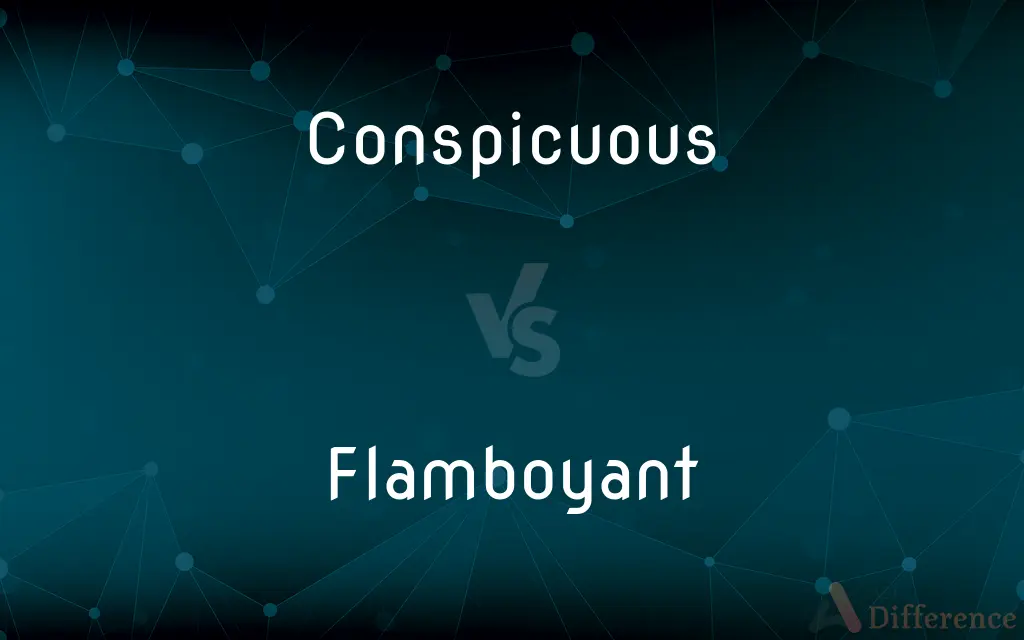Conspicuous vs. Flamboyant — What's the Difference?
Edited by Tayyaba Rehman — By Maham Liaqat — Updated on April 6, 2024
Conspicuous describes something easily seen or noticed, often due to its stark contrast with its surroundings. Flamboyant denotes a style or action that is exuberantly confident, colorful, and full of flair, emphasizing boldness and extravagance.

Difference Between Conspicuous and Flamboyant
Table of Contents
ADVERTISEMENT
Key Differences
Conspicuousness is primarily about visibility and the capacity to stand out from the environment or context, whether intentionally or not. It's about drawing attention through distinct differences in appearance, behavior, or qualities. Whereas flamboyancy is characterized by an expressive, ostentatious display of personality, fashion, or behavior, often with the intention of being noticed and admired for one's uniqueness and vibrancy.
A conspicuous object or person attracts notice due to inherent characteristics or conditions that make it differ markedly from its surroundings. This can be due to color, size, location, or any other trait that makes it prominent. On the other hand, flamboyant individuals or objects exude a deliberate extravagance and theatricality, often embracing bright colors, elaborate designs, and exaggerated behaviors as a means of self-expression and to evoke admiration or entertainment.
While being conspicuous does not necessarily involve any qualitative judgment beyond the fact of being noticeable, flamboyancy often carries connotations of positivity or negativity, depending on the observer's perspective, cultural context, and the situation. Flamboyance is usually associated with a lively and vibrant personality or design, whereas conspicuousness is more neutral, simply indicating that something stands out.
The motivation behind flamboyancy often includes a desire for recognition, celebration of individuality, or the breaking of norms and conventions through visual and behavioral boldness. Conspicuousness, however, might not always be intentional; it could be an inadvertent result of various factors, including environmental mismatch or inherent traits.
Both terms share the concept of visibility but differ significantly in their implications, intentions, and the reactions they provoke. While all flamboyant things are conspicuous, not all conspicuous things are flamboyant, highlighting the distinction between merely being seen and actively seeking to dazzle.
ADVERTISEMENT
Comparison Chart
Definition
Easily seen or noticed
Exuberantly confident and stylish
Key Characteristics
Visibility, contrast
Bright, bold, extravagant
Intent
May not be intentional
Often intentionally eye-catching
Connotations
Neutral, stands out
Positive or negative, lively
Examples
A bright red car among gray vehicles
A person wearing vibrant, elaborate attire
Implications
Draws attention inherently
Seeks to entertain or express individuality
Motivation
Can be unintentional
Desire for recognition, individuality
Perceived by
General visibility
Observer's cultural and personal perspective
Compare with Definitions
Conspicuous
Easily noticeable or attracting attention.
The conspicuous sign made it easy to find the entrance.
Flamboyant
Characterized by exuberance and confidence.
The flamboyant performer captivated the audience.
Conspicuous
Visible due to contrast.
The conspicuous colors of the bird attract mates.
Flamboyant
Seeking attention through boldness.
His flamboyant entrance turned all heads in the room.
Conspicuous
Markedly different from the environment.
His conspicuous absence was noted at the meeting.
Flamboyant
Marked by bright, bold colors or designs.
She wore a flamboyant dress to the gala.
Conspicuous
Standing out from the surroundings.
The lone tree on the hill was conspicuous against the sky.
Flamboyant
Demonstrative of extravagance.
The party was decorated in a flamboyant style.
Conspicuous
Catching the eye unintentionally.
The error in the document was immediately conspicuous.
Flamboyant
Expressing personality or creativity vividly.
The artist's flamboyant works were instantly recognizable.
Conspicuous
Clearly visible
He was very thin, with a conspicuous Adam's apple
Flamboyant
Flamboyant (from French: flamboyant, lit. 'flaming') is a form of late Gothic architecture that developed in Europe in the Late Middle Ages and Renaissance, from around 1375 to the mid-16th century. It is characterized by double curves forming flame-like shapes in the bar-tracery, which give the style its name; by the multiplication of ornamental ribs in the vaults; and by the use of use of the arch in accolade.
Conspicuous
Easy to notice; obvious
A conspicuous flaw in the construction.
Flamboyant
Given to or marked by elaborate, ostentatious, or audacious display or behavior.
Conspicuous
Attracting attention, as by being unusual or remarkable; noticeable.
Flamboyant
Richly or brightly colored; resplendent
A flamboyant turban.
Conspicuous
Obvious or easy to notice.
He was conspicuous by his absence.
Flamboyant
Of, relating to, or having wavy lines and flamelike forms characteristic of 15th- and 16th-century French Gothic architecture.
Conspicuous
Noticeable or attracting attention, especially if unattractive.
He had a conspicuous lump on his forehead.
Flamboyant
See royal poinciana.
Conspicuous
Open to the view; obvious to the eye; easy to be seen; plainly visible; manifest; attracting the eye.
It was a rockOf alabaster, piled up to the clouds,Conspicious far.
Conspicious by her veil and hood,Signing the cross, the abbess stood.
Flamboyant
Showy, bold or audacious in behaviour, appearance, etc.
Conspicuous
Obvious to the mental eye; easily recognized; clearly defined; notable; prominent; eminent; distinguished; as, a conspicuous excellence, or fault.
A man who holds a conspicuous place in the political, ecclesiastical, and literary history of England.
Flamboyant
(architecture) Referring to the final stage of French Gothic architecture from the 14th to the 16th centuries.
Conspicuous
Obvious to the eye or mind;
A tower conspicuous at a great distance
Wore conspicuous neckties
Made herself conspicuous by her exhibitionistic preening
Flamboyant
Of a blade: forged in a wavy, undulating pattern, like a flame-bladed sword or a kris.
Conspicuous
Without any attempt at concealment; completely obvious;
Open disregard of the law
Open family strife
Open hostility
A blatant appeal to vanity
A blazing indiscretion
Flamboyant
The royal poinciana (Delonix regia), a showy tropical tree.
Flamboyant
Characterized by waving or flamelike curves, as in the tracery of windows, etc.; - said of the later (15th century) French Gothic style.
Flamboyant
Showy tropical tree or shrub native to Madagascar; widely planted in tropical regions for its immense racemes of scarlet and orange flowers; sometimes placed in genus Poinciana
Flamboyant
Elaborately or excessively ornamented;
Flamboyant handwriting
The senator's florid speech
Flamboyant
Richly and brilliantly colorful
Common Curiosities
Why do people choose flamboyant styles?
People may choose flamboyant styles to express their personality, seek attention, or celebrate their individuality.
What makes something conspicuous?
Something becomes conspicuous due to its stark contrast with its surroundings, making it easily noticeable.
Can an action be conspicuous?
Yes, actions can be conspicuous when they markedly differ from expected behavior, attracting attention.
Can a building be flamboyant?
Yes, buildings can be flamboyant, especially when they feature extravagant architecture, bold colors, or unique designs.
Is being conspicuous always intentional?
No, being conspicuous can be unintentional, resulting from inherent qualities or situational factors.
How do cultural perceptions affect flamboyancy?
Cultural perceptions significantly influence how flamboyancy is viewed, with reactions varying from admiration to disapproval based on societal norms and values.
How does the context affect the perception of flamboyant behavior?
The context, including the setting, occasion, and cultural background, greatly affects whether flamboyant behavior is seen as appropriate, admirable, or excessive.
Can animals be flamboyant?
Yes, many animals are considered flamboyant due to their bright colors or dramatic mating displays, which are often mechanisms for attracting mates or deterring predators.
What is the relationship between conspicuousness and flamboyancy?
Flamboyancy is a form of conspicuousness characterized by intentional, bold expression, whereas conspicuousness is a broader term that includes any form of visibility or noticeability, intentional or not.
Is it possible for a design to be too flamboyant?
Depending on personal taste and the intended audience, a design can be perceived as overly flamboyant, potentially overshadowing its purpose or message.
Share Your Discovery

Previous Comparison
Lac vs. Las
Next Comparison
Fellow vs. YellowAuthor Spotlight
Written by
Maham LiaqatEdited by
Tayyaba RehmanTayyaba Rehman is a distinguished writer, currently serving as a primary contributor to askdifference.com. As a researcher in semantics and etymology, Tayyaba's passion for the complexity of languages and their distinctions has found a perfect home on the platform. Tayyaba delves into the intricacies of language, distinguishing between commonly confused words and phrases, thereby providing clarity for readers worldwide.
















































